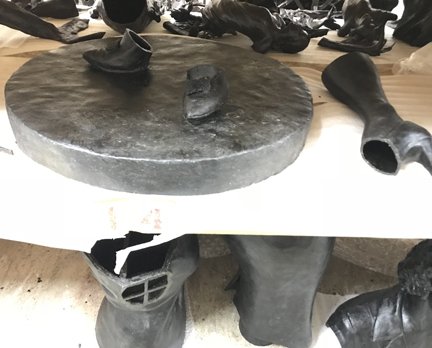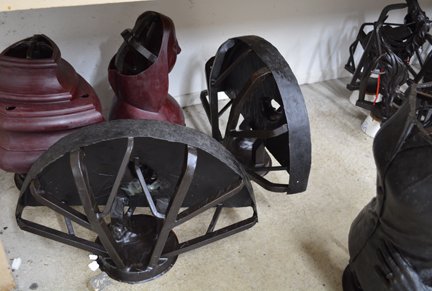FMD #45
The wax sections, fully chased, have been delivered to the Art Castings of Loveland Foundry and are placed on shelves awaiting the next step in the lost wax process.
Now the process of sprueing, gating and venting take place. A sprue is the passage through which liquid material is introduced into a mold. In many cases it controls the flow of material into the mold. During casting or molding, the material in the sprue will solidify and need to be removed from the finished part. This excess material is also called a sprue. Gating is important because when pouring the molten bronze into the mold it must displace the air inside the mold. By making a gate system you provide a way for the air to escape to make room for the metal - otherwise the metal would not flow to the ends because of the trapped air.
In the photo above you will see the base (with the shoes) has been cut in half. This is because at 28” it is too large for the furnace. With the base cut in half, the spider-web of gates attached to the sprue is very strange looking but facilitates the pouring of the bronze and the venting of the air so the liquid bronze can flow. After casting, the spiderweb will appear just like this in bronze and will be cut off from the base. These spare bits in bronze are not wasted - they are simply melted down in later castings for bronze.
Here is the lower section of the body with sprue and gates attached.
The wax casting is first carefully studied and analyzed as to how the bronze will flow. The gates and vents are actually square or round rods and are made entirely of solid wax. They are cast in large batches and placed nearby the sprueing stations ready for use depending upon the size needed. The craftsman decides where a gate, sprue or vent will need to be placed and the wax rod is then cut to size and may be heated and bent into shape as needed.
Sometimes sections are cut out of large areas - such as in the top of the hat. This is because bronze will shrink differently over large sections and can cause rippling, cracking and distortions. So in large areas, they may cut out a section and cast it separately so that the cooling and shrinking portion is more even and less prone to cracking. Those pieces will then be welded back together. Here the craftsman has cut off the top of the hat and is preparing it for accepting the gates. There is an electric hot plate with pots of melted wax that is used to act as glue and patching for the sprue and gates.
You can see more on the process at Art Castings of Loveland.
After all the wax sections have had vents cut and sprues and gates attached they will begin the process of building up the hard ceramic shell.
Below is a video of spruing and gating by Art Castings of Loveland:
Below is a video of spruing and gating by Art Castings of Loveland:










